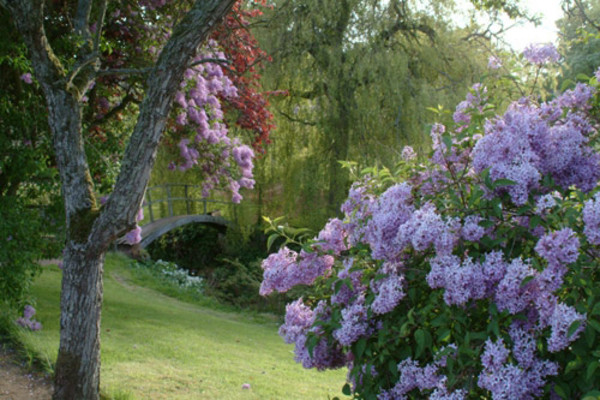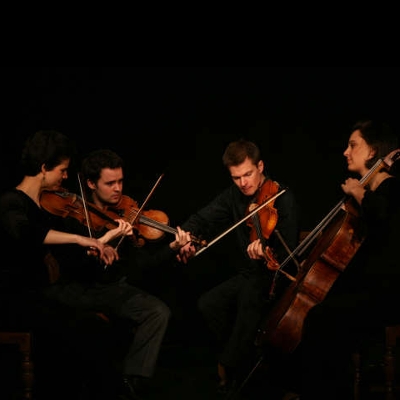East Neuk Festival, Cambo Estate/Crail Church | reviews, news & interviews
East Neuk Festival, Cambo Estate/Crail Church
East Neuk Festival, Cambo Estate/Crail Church
This Scottish festival is small but perfectly-formed

Scotland’s East Neuk is a little like Hardy’s Wessex – less a geographical specific and more an idea, a resonance. Tucked up into the crook of the Firth of Forth, directly below St Andrews, the region encompasses the tiny coastal towns of Crail, Pittenweem, Anstruther and St Monans, where stern stone cottages and still sterner churches have done battle with the elements since at least the 9th century.
Founded in 2005, the festival has always maintained an eclectic mixture of musics, but contemporary works have remained a constant. Last weekend however saw East Neuk’s most ambitious project to date. Inspired by Adams’ home landscape of Alaska and conceived for outdoor performance, John Luther Adams’ Inuksuit is more sound installation than a piece in the conventional sense. Any work for which the use of “GPS units”, “topographic maps” and “tents” is potentially advised leaves little doubt of its progressive credentials. In its Scottish iteration however no tents were required, with the performance framed in the glorious walled garden (pictured below right) of East Neuk’s Cambo Estate.
 Thirty percussionists sprouted from borders, stood framed in willow branches and were dispersed across lawns. The audience were encouraged to wander, chasing sounds as we wished, or simply sitting down and letting them fan out around us. In practice most of us did both, lulled into stillness by the work’s contemplative outer sections, but stirred into movement by its central animation – fulfilling Adams’ own creative vision of spatial and sonic blurring.
Thirty percussionists sprouted from borders, stood framed in willow branches and were dispersed across lawns. The audience were encouraged to wander, chasing sounds as we wished, or simply sitting down and letting them fan out around us. In practice most of us did both, lulled into stillness by the work’s contemplative outer sections, but stirred into movement by its central animation – fulfilling Adams’ own creative vision of spatial and sonic blurring.
Enacting “a single breath”, the work grows out of husky, unpitched breathings, the gentlest of blowings into man-made tubes that duetted here with the gulps of the stream, before growing into percussive violence as sirens and bullroarers give voice. It’s confrontingly primal, with instruments often establishing tense duets and trios, batting sounds to and fro across the space in combative style. But for all the score’s inherent freedoms, there’s nothing anarchic about Inuksuit. Perhaps this was the careful direction of Bang On A Can’s Steve Schick (who has a long and intimate association with the work), but the generous abstraction of the concept invites listeners to fill it with narrative, while keeping the musical structure simple enough to act as scaffolding to any number of stories.
 At the other musical extreme from Adams’ experimentalism, East Neuk also offers a programme of core chamber works. One ensemble who have been regular visitors to the festival (and will return again next year) are the Elias Quartet (pictured left), whose first of two concerts paired Schumann’s Quartet No. 1 Op. 41 with Beethoven’s No. 13 in B-flat major, Op. 130.
At the other musical extreme from Adams’ experimentalism, East Neuk also offers a programme of core chamber works. One ensemble who have been regular visitors to the festival (and will return again next year) are the Elias Quartet (pictured left), whose first of two concerts paired Schumann’s Quartet No. 1 Op. 41 with Beethoven’s No. 13 in B-flat major, Op. 130.
Former Radio 3 New Generation Artists, the quartet have been quietly establishing themselves among the UK’s leading young ensembles over the past few years and are currently working on an extended Beethoven project. But before the meat of the Beethoven with its mighty Grosse Fugure finale, we opened with Webern’s emotive miniature Langsamer satz. The quartet’s blend lent burnished unanimity to the opening, never over-complicating the musical sincerity. Yet for all their accomplished simplicity, doing less so elegantly where more might have been the easy option, they didn’t quite find the strength to force the moment to its crisis, to follow Webern into his youthful extremity of emotion.
Any doubts though found little foothold in the Beethoven – calibrated minutely to allow for the weightier finale, building from the throwaway wit and ebullience of the Presto into a measured Andante before stripping all right back (our resistance too) for the Cavatina, flaying us bare in preparation for the fugue. Here, only a slightly underweighted viola, blurred a serious climax, showcasing the quartet’s technical abilities but also their expressive control, never allowing the beast to dominate them and their interpretative choices.
rating
Explore topics
Share this article
The future of Arts Journalism
You can stop theartsdesk.com closing!
We urgently need financing to survive. Our fundraising drive has thus far raised £49,000 but we need to reach £100,000 or we will be forced to close. Please contribute here: https://gofund.me/c3f6033d
And if you can forward this information to anyone who might assist, we’d be grateful.

Subscribe to theartsdesk.com
Thank you for continuing to read our work on theartsdesk.com. For unlimited access to every article in its entirety, including our archive of more than 15,000 pieces, we're asking for £5 per month or £40 per year. We feel it's a very good deal, and hope you do too.
To take a subscription now simply click here.
And if you're looking for that extra gift for a friend or family member, why not treat them to a theartsdesk.com gift subscription?
more Classical music
 Scottish Chamber Orchestra, Ibragimova, Queen’s Hall, Edinburgh review - rarities, novelties and drumrolls
A pity the SCO didn't pick a better showcase for a shining guest artist
Scottish Chamber Orchestra, Ibragimova, Queen’s Hall, Edinburgh review - rarities, novelties and drumrolls
A pity the SCO didn't pick a better showcase for a shining guest artist
 Kilsby, Parkes, Sinfonia of London, Wilson, Barbican review - string things zing and sing in expert hands
British masterpieces for strings plus other-worldly tenor and horn - and a muscular rarity
Kilsby, Parkes, Sinfonia of London, Wilson, Barbican review - string things zing and sing in expert hands
British masterpieces for strings plus other-worldly tenor and horn - and a muscular rarity
 From Historical to Hip-Hop, Classically Black Music Festival, Kings Place review - a cluster of impressive stars for the future
From quasi-Mozartian elegance to the gritty humour of a kitchen inspection
From Historical to Hip-Hop, Classically Black Music Festival, Kings Place review - a cluster of impressive stars for the future
From quasi-Mozartian elegance to the gritty humour of a kitchen inspection
 Shibe, LSO, Adès, Barbican review - gaudy and glorious new music alongside serene Sibelius
Adès’s passion makes persuasive case for the music he loves, both new and old
Shibe, LSO, Adès, Barbican review - gaudy and glorious new music alongside serene Sibelius
Adès’s passion makes persuasive case for the music he loves, both new and old
 Anja Mittermüller, Richard Fu, Wigmore Hall review - a glorious hall debut
The Austrian mezzo shines - at the age of 22
Anja Mittermüller, Richard Fu, Wigmore Hall review - a glorious hall debut
The Austrian mezzo shines - at the age of 22
 First Person: clarinettist Oliver Pashley on the new horizons of The Hermes Experiment's latest album
Compositions by members of this unusual quartet feature for the first time
First Person: clarinettist Oliver Pashley on the new horizons of The Hermes Experiment's latest album
Compositions by members of this unusual quartet feature for the first time
 Gesualdo Passione, Les Arts Florissants, Amala Dior Company, Barbican review - inspired collaboration excavates the music's humanity
At times it was like watching an anarchic religious procession
Gesualdo Passione, Les Arts Florissants, Amala Dior Company, Barbican review - inspired collaboration excavates the music's humanity
At times it was like watching an anarchic religious procession
 Classical CDs: Camels, concrete and cabaret
An influential American composer's 90th birthday box, plus British piano concertos and a father-and-son duo
Classical CDs: Camels, concrete and cabaret
An influential American composer's 90th birthday box, plus British piano concertos and a father-and-son duo
 Cockerham, Manchester Camerata, Sheen, Martin Harris Centre, Manchester review - re-enacting the dawn of modernism
Two UK premieres added to three miniatures from a seminal event of January 1914
Cockerham, Manchester Camerata, Sheen, Martin Harris Centre, Manchester review - re-enacting the dawn of modernism
Two UK premieres added to three miniatures from a seminal event of January 1914
 Kempf, Brno Philharmonic, Davies, Bridgewater Hall, Manchester review - European tradition meets American jazz
Bouncing Czechs enjoy their Gershwin and Brubeck alongside Janáček and Dvořák
Kempf, Brno Philharmonic, Davies, Bridgewater Hall, Manchester review - European tradition meets American jazz
Bouncing Czechs enjoy their Gershwin and Brubeck alongside Janáček and Dvořák
 Solomon, OAE, Butt, QEH review - daft Biblical whitewashing with great choruses
Even a top soprano and mezzo can’t make this Handel paean wholly convincing
Solomon, OAE, Butt, QEH review - daft Biblical whitewashing with great choruses
Even a top soprano and mezzo can’t make this Handel paean wholly convincing
 Two-Piano Gala, Kings Place review - shining constellations
London Piano Festival curators and illustrious friends entertain and enlighten
Two-Piano Gala, Kings Place review - shining constellations
London Piano Festival curators and illustrious friends entertain and enlighten

Add comment